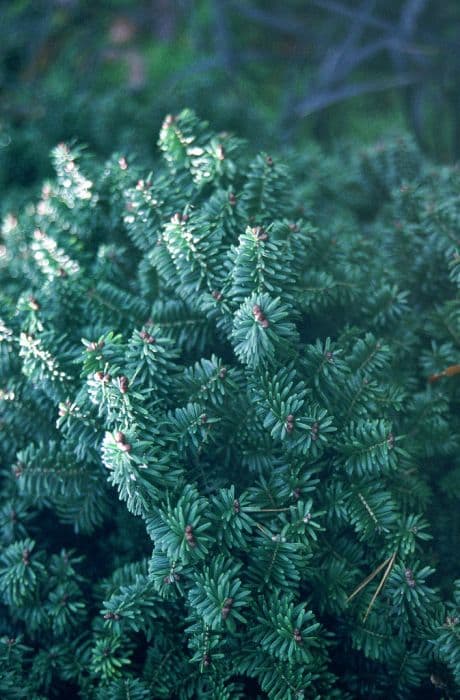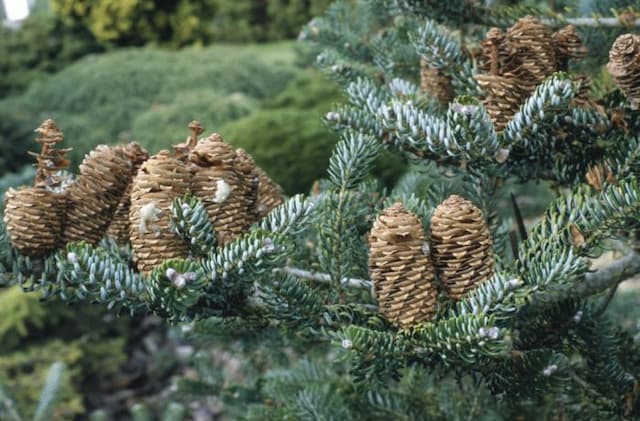Pinus thunbergii 'Ogon'

ABOUT
The Japanese black pine 'Ogon' is a striking variety of pine known for its unique appearance. It boasts a rugged, irregular growth habit that adds a touch of wild natural beauty to the landscape. Its needles are a show-stopping feature—vibrant golden-yellow in color, which stand out brilliantly against the typical greens found in a garden setting, especially in the winter months. These long, slender needles grow in dense clusters at the ends of the branches, giving the tree a full and lively look. The bark of the Japanese black pine 'Ogon' contrasts beautifully with its bright foliage, displaying a rich texture with deep furrows and ridges that add to its overall dramatic appearance. During the spring, fresh new growth emerges, enhancing the golden display of the plant. The tree's cones are another point of interest—they are small and can be found nestled among the branches, starting off green before maturing to a brown color. With its distinctive coloration and textured bark, the Japanese black pine 'Ogon' is a colorful addition to the landscape, providing year-round visual interest without growing too large for the average garden space.
About this plant
 Names
NamesFamily
Pinaceae.
Synonyms
Japanese Black Pine, Thunderhead Pine, Japanese Pine, Black Pine.
Common names
Pinus thunbergii 'Ogon'.
 Toxicity
ToxicityTo humans
The Japanese black pine 'Ogon' is not commonly known as a toxic plant to humans. While it is generally not considered to be poisonous, it is not edible and ingesting parts of the pine, such as needles, sap, or seeds, is not advisable. If consumed in large quantities, the needles could cause physical irritation or a puncture in the digestive tract due to their sharpness and indigestibility. However, typical exposure or handling of the plant does not pose a risk of poisoning or serious health consequences to humans.
To pets
The Japanese black pine 'Ogon' is also not known to be toxic to pets. Much like in humans, it is not meant for consumption, and eating parts of the plant may cause minor issues such as gastrointestinal upset due to the indigestible nature of the needles. In general, the plant is not associated with serious toxicity or poisoning in pets, but it is always a good practice to prevent pets from ingesting plants, as individual animals may react differently, and other unforeseen complications could arise from ingestion.
 Characteristics
CharacteristicsLife cycle
Perennials
Foliage type
Evergreen
Color of leaves
Yellowish-green
Height
15-20 feet (4.6-6 meters)
Spread
10-15 feet (3-4.6 meters)
Plant type
Tree
Hardiness zones
5-9
Native area
Japan
Benefits
 General Benefits
General Benefits- Ornamental appeal: Pinus thunbergii 'Ogon', commonly known as Japanese Black Pine 'Ogon', showcases striking golden-yellow foliage that adds year-round interest and color contrast to gardens and landscapes.
- Drought tolerance: Once established, this variety of Japanese Black Pine is tolerant of dry conditions, making it suitable for xeriscaping and drought-prone areas.
- Coastal resilience: It holds up well in coastal environments, tolerating salt spray and wind, which makes it a good choice for seaside planting schemes.
- Windbreak: With its robust nature, it serves as an effective windbreak, protecting other plants and outdoor living spaces from strong winds.
- Erosion control: The deep root system of the 'Ogon' helps to stabilize soil and prevent erosion on slopes and hillsides.
- Wildlife habitat: This pine provides shelter and nesting sites for birds, as well as serving as a food source for various wildlife.
- Low maintenance: It requires minimal upkeep once established, making it a convenient choice for gardeners seeking a low-maintenance landscape option.
- Bonsai potential: Enthusiasts value Pinus thunbergii 'Ogon' for its unique color and form, often utilizing it in the art of bonsai for a striking display.
- Soil adaptability: Japanese Black Pine 'Ogon' is adaptable to a wide range of soil types, although it prefers well-drained soils, enhancing its versatility in different garden settings.
- Privacy screening: Its dense growth habit allows it to be used as a living privacy screen or hedge, offering a natural barrier for yards and gardens.
 Medical Properties
Medical PropertiesThis plant is not used for medical purposes.
 Air-purifying Qualities
Air-purifying QualitiesThis plant is not specifically known for air purifying qualities.
 Other Uses
Other Uses- Coastal Barrier - The Japanese Black Pine 'Ogon' is often planted to stabilize sand and act as a windbreak along coastal areas due to its tolerance to salt and windy conditions.
- Bonsai Making - Its unique golden needles and robust form make it a popular choice for creating bonsai trees, allowing enthusiasts to appreciate its beauty on a miniature scale.
- Artistic Inspiration - The striking appearance of the 'Ogon', with its golden foliage, serves as an inspiring subject for artists, particularly in traditional Japanese painting and gardening aesthetics.
- Soil Erosion Control - The root system of the Japanese Black Pine 'Ogon' helps to prevent soil erosion, particularly on slopes and banks where erosion might otherwise be a significant problem.
- Photography Backdrops – The aesthetic form and texture of this pine variety make it a sought-after backdrop for photographers, especially in garden and nature-themed compositions.
- Cultural Symbolism - In Japan, the Japanese Black Pine, including 'Ogon', is seen as a symbol of endurance and longevity and is often used in cultural celebrations and narratives.
- Forest Gardens - This tree can be incorporated into forest gardens as a structural element, providing habitat for wildlife and contributing to the overall ecosystem.
- Urban Green Spaces - 'Ogon' is utilized in urban planning for green space areas where its ability to withstand pollution and harsh conditions is beneficial.
- Christmas Decor - Although less traditional, the Japanese Black Pine 'Ogon' can be used as a Christmas tree alternative, offering a unique twist on holiday decor.
- Educational Tool - The species can be used as an educational tool to teach about pine tree varieties, conifer adaptations, and the importance of biodiversity in plant life.
Interesting Facts
 Feng Shui
Feng ShuiThe Japanese Black Pine is not used in Feng Shui practice.
 Zodiac Sign Compitability
Zodiac Sign CompitabilityThe Japanese Black Pine is not used in astrology practice.
 Plant Symbolism
Plant Symbolism- Endurance and Longevity: Pinus thunbergii 'Ogon', commonly known as the Japanese Black Pine, is often associated with endurance and the ability to withstand challenging conditions. This is due to the species' natural habit of growing in harsh, coastal environments and its long lifespan.
- Resilience: The Japanese Black Pine symbolizes resilience because of its capacity to resist strong winds and salt sprays, often embodying the idea of bouncing back and standing firm in the face of adversity.
- Fidelity: In Japanese culture, pine trees represent fidelity and loyalty, as they remain evergreen and consistent throughout the seasons, paralleling the steadfastness expected in faithful relationships.
- Long-lasting Friendship: Its evergreen nature and durability over time also make the Japanese Black Pine a symbol of long-lasting friendship, suggesting a bond that endures regardless of the trials and changes in life.
 Water
WaterThe Japanese Black Pine 'Ogon' should be watered deeply to ensure the soil is moist but not saturated, as it does not tolerate wet feet. Generally, young trees require watering every 7 to 10 days during the growing season, but established trees can go longer between waterings, depending on weather conditions. During dry spells, it may need watering every week; apply about 10 to 15 gallons of water per session for mature trees, ensuring it reaches the root zone.
 Light
LightThe Japanese Black Pine 'Ogon' thrives in full sunlight. It needs at least six hours of direct, unfiltered sunlight each day to maintain its health and vigorous growth. The best spot for the 'Ogon' would be an open area away from taller structures or trees that could create significant shade.
 Temperature
TemperatureThe Japanese Black Pine 'Ogon' is hardy and can withstand a wide range of temperatures. It can survive minimal winter temperatures down to about 0 degrees Fahrenheit, but prefers a range of 60 to 70 degrees Fahrenheit for optimal growth. It can tolerate heat well, making it versatile for various climates, but should be protected from extreme cold snaps below its hardiness threshold.
 Pruning
PruningPrune the Japanese Black Pine 'Ogon' to remove dead or damaged branches and to shape it for aesthetic purposes or to control growth. It is best pruned in late winter or early spring before new growth starts. Pinching back the new shoots, called "candles," in mid to late spring can help encourage a denser growth habit. Pruning every year or two is sufficient for the health and appearance of this plant.
 Cleaning
CleaningAs needed
 Soil
SoilFor the Japanese Black Pine 'Ogon', the ideal soil mix should be well-draining with a slightly acidic to neutral pH of 5.5 to 7.0. Incorporate a blend of one-third topsoil, one-third peat moss, and one-third sharp sand or pumice to ensure good drainage and aeration.
 Repotting
RepottingJapanese Black Pine 'Ogon' should be repotted every two to three years during early spring before new growth emerges. This routine helps refresh the soil and prevent root circling.
 Humidity & Misting
Humidity & MistingJapanese Black Pine 'Ogon' is adaptable and can handle a range of outdoor humidity conditions. It does not require any specific humidity level.
 Suitable locations
Suitable locationsIndoor
Ensure bright light and good airflow for Japanese Black Pine 'Ogon'.
Outdoor
Plant in full sun, well-draining soil for Japanese Black Pine 'Ogon'.
Hardiness zone
5-9 USDA
 Life cycle
Life cyclePinus thunbergii 'Ogon', commonly known as the Golden Japanese black pine, begins its life cycle as a seed, which after conditions of moisture and temperature are met, will germinate and emerge as a seedling. The seedling stage involves the growth of basic root, stem, and needle structures, which develop over a few years before the plant enters the sapling stage, characterized by increased growth rates and the initial development of the characteristic pine shape. As the tree matures into an adult, it develops a thick trunk, robust branches, and dense foliage, including long, golden-yellow needles distinctive to the 'Ogon' cultivar, and begins reproductive cycles by producing both male and female cones. Pollination occurs typically through wind, with male cones spreading pollen to female cones, which upon fertilization will develop seeds over time. Once the seeds mature, they are dispersed by gravity, wind, or wildlife, thereby beginning the cycle anew if they land in appropriate growing conditions. The pines continue to grow and contribute to their species' perpetuation over the course of decades, capable of living for well over a hundred years under optimal conditions.
 Propogation
PropogationPropogation time
Early Spring
The Japanese Black Pine 'Ogon', a variegated variety of Pinus thunbergii, is typically propagated through grafting, which is the most popular method for this cultivar due to the need to maintain the specific characteristics of the 'Ogon' variant. Grafting is often carried out during the late winter or early spring before new growth begins. This involves taking a piece of the 'Ogon' pine, known as the scion, with the desirable characteristics, and physically attaching it to a rootstock, which is usually a seedling of a more generic Japanese Black Pine. The grafting site is then bound with grafting tape or a similar material to hold it in place while the scion and the rootstock fuse together, a process that can take several months to a year. Successful grafts will display the yellowish variegation that 'Ogon' is known for while benefiting from the vigorous root system of the understock.









